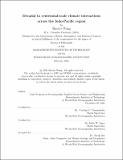Decadal to centennial-scale climate interactions across the Indo-Pacific region
Author(s)
Wang, Shouyi
DownloadThesis PDF (33.19Mb)
Advisor
Ummenhofer, Caroline C.
Oppo, Delia W.
Terms of use
Metadata
Show full item recordAbstract
An improved understanding of decadal to centennial-scale climate variability is critical for properly attributing recently observed low-frequency changes to internal climate oscillations and/or anthropogenic forcings as well as improving predictability of decadal variability. This thesis investigates ocean and atmospheric circulation changes and associated impacts within the tropical Indo-Pacific, where low-frequency changes in heat and freshwater impact the livelihoods of billions of people. Because the instrumental record is too short to investigate centennial variability, this thesis leverages numerical simulations and records from paleoclimate archives to provide insights into low-frequency tropical dynamics. In Chapter 2, we explore the dynamics that drive Indonesian Throughflow surface transport variability using a series of forced global high-resolution ocean simulations. We show that surface wind changes associated with Pacific decadal variability drive changes in the western boundary currents that modulate the Indonesian throughflow, consistent with mechanisms identified on interannual timescales. This work identifies a relationship between atmospheric circulation and transport through a key low-latitude passageway. Motivated by paleoclimate evidence of multi-year droughts in Southeast Asia, we investigate their potential drivers in Chapter 3 using an ensemble of coupled climate model simulations. These simulations illustrate that Indo-Pacific internal variability dominated Southeast Asian rainfall extremes during the last millennium, although the influence of volcanic eruptions was detectable. We found that multi-year pluvials were contributed by both Pacific and Indian Ocean modes, while droughts were largely only driven by Pacific Ocean impacts. Our analysis not only quantifies the role of internal and external drivers to Southeast Asia rainfall but also presents a probabilistic analysis framework that may be useful for water resources prediction. Lastly, in Chapter 4 we reconstruct the Indian and Pacific Walker circulations and the Indian Ocean Basin Mode by synthesizing tropical records (corals, tree-rings, and speleothems) of past ocean and atmospheric conditions to investigate basin interactions over the past four centuries. Our results demonstrate that IndoPacific climate was generally coupled on decadal-centennial timescales throughout the past four centuries but was notably decoupled in the early 19th century. Using climate models, we attribute this decoupling to a series of strong volcanic eruptions. Dynamically, we link this inter-basin decoupling to volcanically induced changes in hemispheric temperature gradients, which modulate the teleconnections across the Indo-Pacific. These past disruptions in basin interactions provide context for ongoing and simulated future decoupling under a high emission scenario, as global warming also alters interhemispheric temperature gradients. This thesis sheds light on the complex dynamics that drive ocean-atmosphere variability across the Indo-Pacific on decadal to centennial timescales.
Date issued
2025-02Department
Massachusetts Institute of Technology. Department of Earth, Atmospheric, and Planetary SciencesPublisher
Massachusetts Institute of Technology